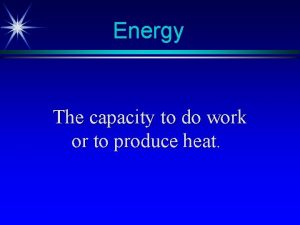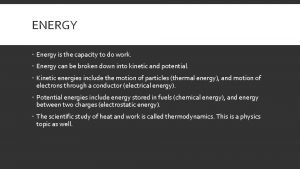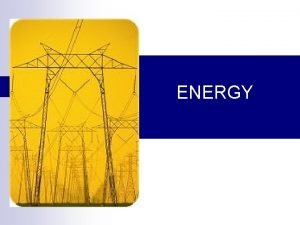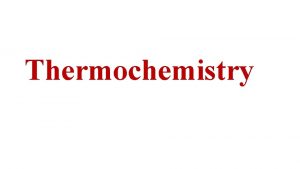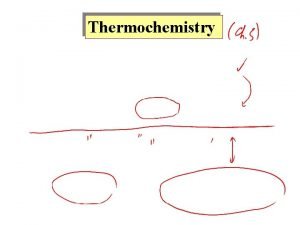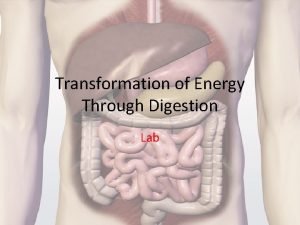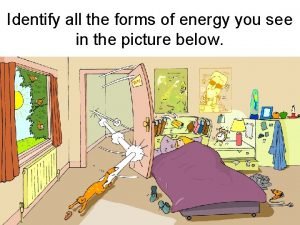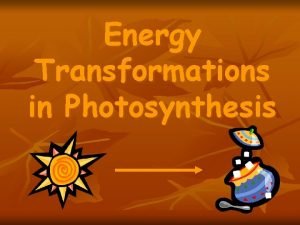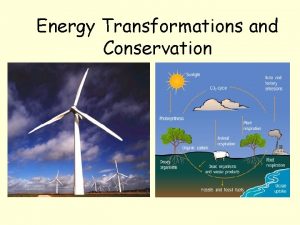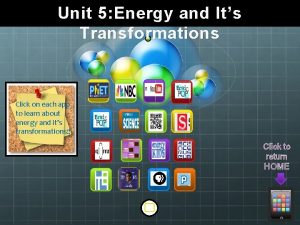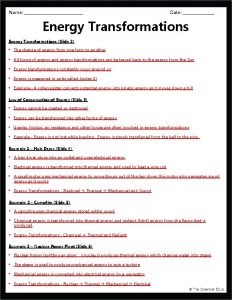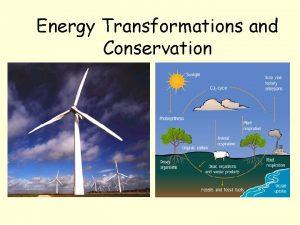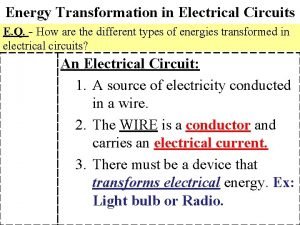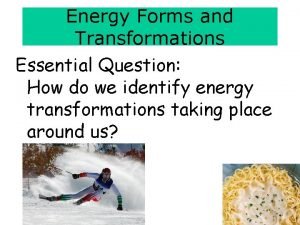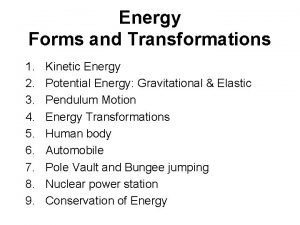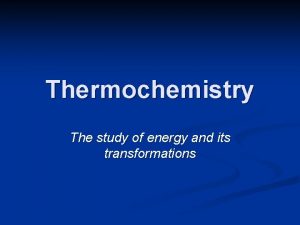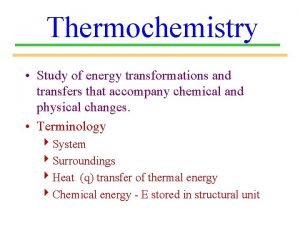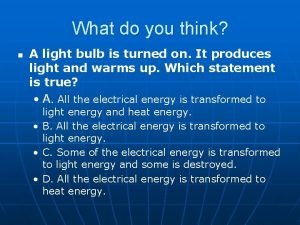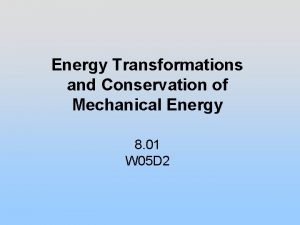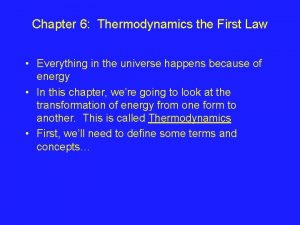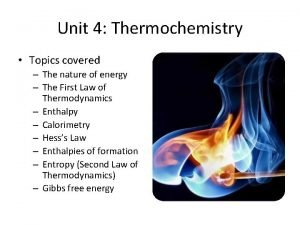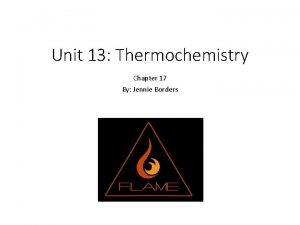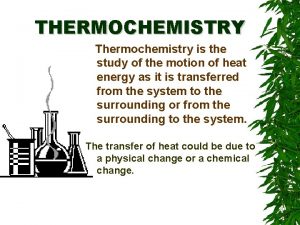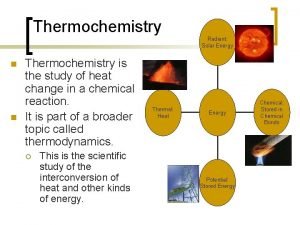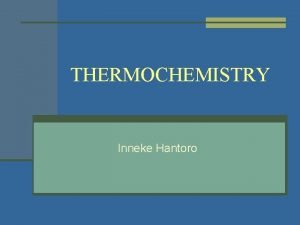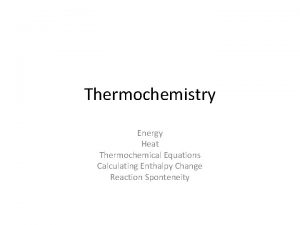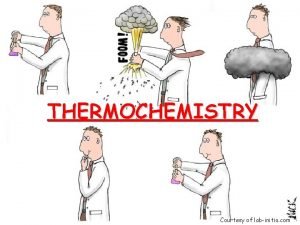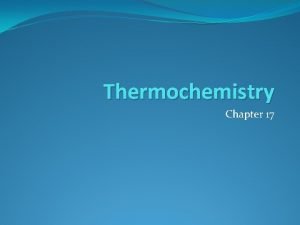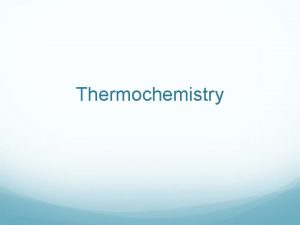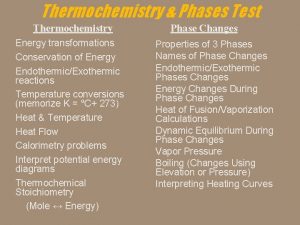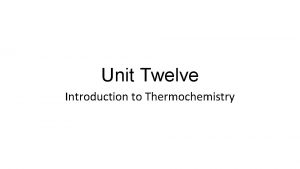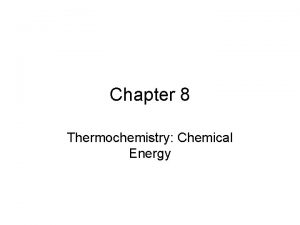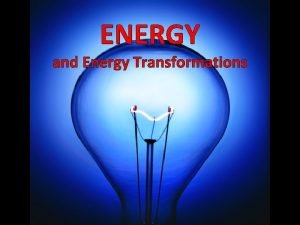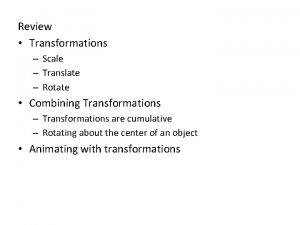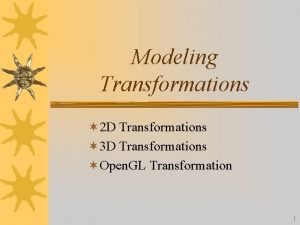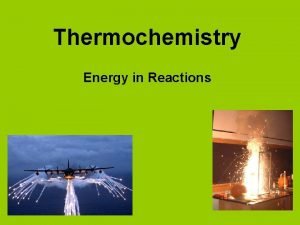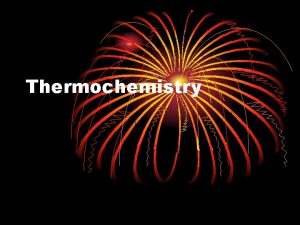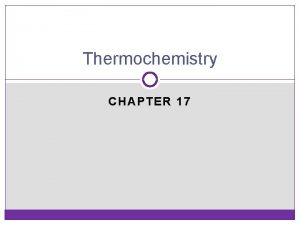Thermochemistry Energy Transformations Energy capacity to do work




























![Example A + B ⇋ ΔHfo[A] = 433 KJ/mol ΔHfo[B] = -256 KJ/mol ΔHfo[C] Example A + B ⇋ ΔHfo[A] = 433 KJ/mol ΔHfo[B] = -256 KJ/mol ΔHfo[C]](https://slidetodoc.com/presentation_image/1383a8f1ce372fb95573623b22ffde5f/image-29.jpg)







- Slides: 36

Thermochemistry


Energy Transformations Energy = capacity to do work Work = energy change resulting from a process Thermal energy—KE associated with motion of particles Chemical energy—potential energy stored within the structural units of chemical substances. Units 4184 Joules (J) = 1000 calories (cal) = 1 Calorie (kcal, C)

Energy Transformations First Law of Thermodynamics—law of conservation of energy. ΔU = q + w ΔU = change in internal energy (state function) q = heat w = work (F x d)

Sign Conventions Process Sign Work done by the system on surroundings − Work done by surroundings on system + Heat absorbed by system from surroundings Heat absorbed by surroundings from system – +

Identify each energy exchange as heat or work and determine the sign. An ice cube melts and cools the surrounding beverage (ice cube is the system). A metal cylinder is rolled up a ramp (cylinder is the system) Steam condenses on skin, causing a burn (condensing steam is the system)

Practice The work done when a gas is compressed in a cylinder is 462 J. During this process, 128 J of heat is transferred from the gas to the surroundings. Calculate the internal energy change for this process. A gas expands and does work on the surroundings equal to 325 J. At the same time, it absorbs 127 J of heat from the surroundings. Calculate the change in internal energy of the gas.

Pressure-Volume Work done by gases w = −PΔV P = gas pushing against external pressure Gas pushes against external pressure (expansion), or external pressure pushes against gas (compression) Gas expansion—ΔV = +, work is Gas compression—ΔV = -, work is + 1 L atm = 101. 3 J

Practice A balloon is inflated to its full extent by heating the air inside it. In the final stages of this process, the volume of the balloon changes from 4. 00× 106 L to 4. 50× 106 L by the addition of 1. 3× 106 J of heat. Assuming the balloon expands against a constant pressure of 1. 0 atm, calculate the change in internal energy for this process.

Practice A certain gas expands in volume from 3. 0 L to 5. 0 L at constant temperature. Calculate the work done by the gas if it expands A. against a vacuum B. against an external pressure of 1. 5 atm.

Practice Calculate the work done when 50. 0 g of tin dissolves in excess acid at 1. 00 atm and 25 o. C. Assume ideal gas behavior. Sn(s) + 2 H+(aq) Sn 2+(aq) + H 2(g)

Heat (q) = energy that transfers from one object to another because of a temperature difference. Only changes in heat can be detected. Zeroth Law of Thermodynamics—no heat is transferred between objects at thermal equilibrium.

Quantifying Heat Thermal equilibrium—heat transfer from system to surroundings or visa versa stops. Measure of heat transfer based on two things: Number of molecules Heat capacity of system

Quantifying Heat capacity (C)—the amount of heat required to change to temperature of a substance by 1 o. C. Unit = J/o. C Extensive property—depends on amount of substance Specific heat (s)—the amount of heat required to raise the temperature of 1 gram of substance by 1 o. C. Units = J/g o. C Molar heat capacity Intensive property—depends on kind of substance

Quantifying Heat q = mcΔT Used to calculate the amount of heat being transferred with a given temperature increase.

Practice Suppose you find a penny in the snow. How much heat is absorbed by the penny as it warms from the temperature of the snow, -8 o. C, to the temperature of your hand, 37 o. C? Assume the penny is pure copper and has a mass of 3. 10 g, and the specific heat of copper is 0. 385 J/g o. C.

A home solar energy storage unit uses 400 L of water for storing thermal energy. On a sunny day, the initial temperature of the water is 22. 0°C. During the course of the day, the temperature of the water rises to 38. 0°C as it circulates through the water wall. How much energy, in joules, has been stored in the water? (The density of water at 22. 0°C is 0. 998 g/m. L, and the specific heat of water is 4. 18 J/g • °C)

Heat Transfers Objects will transfer energy until they reach thermal equilibrium. Assume substances are thermally isolated. Two conditions: Isobaric—constant pressure Isochoric—constant volume

Isobaric conditions aka Coffee-cup calorimetry A 32. 5 g sample of aluminum initially at 45. 8 o. C is submerged into 105. 3 g of water at 15. 4 o. C. What is the final temperature of both substances at thermal equilibrium? Cs, Al = 0. 903 J/g o. C Cs, H 2 O = 4. 18 J/g o. C

Specific Heat Quiz What is the specific heat of a material if a 6. 0 gram sample absorbs 50. 0 joules when heated from 30°C to 50°C? A piece of metal weighing 59. 047 g was heated to 100. 0 °C and then put into 100. 0 g of water (initially at 23. 7 °C). The metal and water were allowed to come to thermal equilibrium, determined to be 27. 8 °C. Assuming no heat lost to the environment, calculate the specific heat of the metal.

Measuring ΔU for reactions Bomb calorimeter—measures change in internal energy for combustion reactions. Reaction under constant volume qcal = Ccal × ΔT Ccal determined in separate experiment by burning substance that gives off a known amount of heat.


Bomb Calorimetry qcal = −qrxn When 1. 010 g of sucrose (C 12 H 22 O 11) undergoes combustion in a bomb calorimeter, the temperature rises from 24. 92 o. C to 28. 33 o. C. Find ΔU for the combustion of sucrose in k. J/mol of sucrose. The heat capacity of the bomb calorimeter is 4. 90 k. J/o. C.

Bomb Calorimetry A 1. 000 g sample of octane (C 8 H 18) is burned in a bomb calorimeter containing 1200. grams of water at an initial temperature of 25. 00ºC. After the reaction, the final temperature of the water is 33. 20ºC. The heat capacity of the bomb is 837 J/ºC. The specific heat of water is 4. 184 J/g ºC. Calculate the heat of combustion of octane in k. J/mol.

Enthalpy ∆H = ∆U + P∆V In an isobaric process, enthalpy = change in heat Useful for chemical reactions at constant pressure (open systems) Can be found from: Stoichiometry Standard enthalpy of formation Hess’s Law Calorimetry Bond energies

Stoichiometrically Upon adding solid potassium hydroxide pellets to water the following reaction takes place: KOH(s) → KOH(aq) + 43 k. J/mol Answer the following questions regarding the addition of KOH to water: Does the beaker get warmer or colder? Is the reaction endothermic or exothermic? What is the enthalpy change for the dissolution of the 14. 0 grams of KOH?

Heats of Formation For reaction: a. A + b. B c. C + d. D ΔHrxn = [cΔHof(C) + dΔHof(D)] – [aΔHof(A) + bΔHof(B)] Note*--ΔHof of a pure element is in its reference form is 0.

Example Between Br 2(l) and Br 2(g) at 298. 15 K, which substance has a nonzero standard enthalpy of formation?
![Example A B ΔHfoA 433 KJmol ΔHfoB 256 KJmol ΔHfoC Example A + B ⇋ ΔHfo[A] = 433 KJ/mol ΔHfo[B] = -256 KJ/mol ΔHfo[C]](https://slidetodoc.com/presentation_image/1383a8f1ce372fb95573623b22ffde5f/image-29.jpg)
Example A + B ⇋ ΔHfo[A] = 433 KJ/mol ΔHfo[B] = -256 KJ/mol ΔHfo[C] = 523 KJ/mol Find ΔHrxno C

Hess’s Law Enthalpy is independent of the reaction pathway. If you can find a combination of chemical equations that add up to give you the desired overall equation, you can also sum up the ∆H’s for the individual reactions to get the overall ∆Hrxn.

Example Calculate the ∆H for this overall reaction 2 H 3 BO 3(aq) → B 2 O 3(s) + 3 H 2 O(l) given the following equations: H 3 BO 3(aq) → HBO 2(aq) + H 2 O(l) ∆H = − 0. 02 k. J/molrxn H 2 B 4 O 7(aq) + H 2 O(l) → 4 HBO 2(aq) ∆ H = − 11. 3 k. J/molrxn H 2 B 4 O 7(aq) → 2 B 2 O 3(s) + H 2 O(l) ∆ H = 17. 5 k. J/molrxn

Using Bond Energies Bonds broken – bonds formed = enthalpy of reaction Use the following data table to calculate ∆Hrxn Bond enthalpy (k. J mol-1) C-H +413 Cl-Cl +243 C-Cl +346 H-Cl +432

Heat of Solution Determined by constant pressure calorimetry ∆ Hsoln = U + ∆Hhydration U = lattice energy ∆Hhydration = tabulated info More likely to be asked how much energy is given off when a certain mass of substance is dissolved.

Energy Diagrams


In a coffee cup calorimeter, 100. 0 m. L of 1. 0 M Na. OH and 100. 0 m. L of 1. 0 M HCl are mixed. Both solutions were originally at 24. 6°C. After the reaction, the final temperature is 31. 3°C. Assuming that all solutions have a density of 1. 0 g/cm 3 and a specific heat capacity of 4. 184 J/g°C, calculate the enthalpy change for the neutralization of HCl by Na. OH. Assume that no heat is lost to the surroundings or the calorimeter.
 Capacity to do work
Capacity to do work The capacity to do work.
The capacity to do work. Energy is the capacity to do work.
Energy is the capacity to do work. Energy is the capacity to do work.
Energy is the capacity to do work. Energy diagram thermochemistry
Energy diagram thermochemistry Kinetic energy thermochemistry
Kinetic energy thermochemistry Design capacity and effective capacity examples
Design capacity and effective capacity examples Physics 03-06 impulse and momentum answer key
Physics 03-06 impulse and momentum answer key Chapter 4 work and energy section 1 work and machines
Chapter 4 work and energy section 1 work and machines Energy transformation during digestion
Energy transformation during digestion Identify energy transformations
Identify energy transformations Radiant energy in photosynthesis
Radiant energy in photosynthesis Single transformation of energy
Single transformation of energy Virtual labs energy transformation
Virtual labs energy transformation 7 types of energy
7 types of energy Energy transformation in electric guitar
Energy transformation in electric guitar Energy transformations and conservation
Energy transformations and conservation Energy transformation in
Energy transformation in Energy forms and transformations
Energy forms and transformations Energy transformation
Energy transformation Study of energy and its transformations
Study of energy and its transformations Study of energy and its transformations
Study of energy and its transformations A light bulb energy transformation
A light bulb energy transformation Mechanical energy meaning
Mechanical energy meaning Capacity to do work is called
Capacity to do work is called Section 2 describing energy
Section 2 describing energy Gibbs free energy unit
Gibbs free energy unit Chapter 17 thermochemistry practice problems
Chapter 17 thermochemistry practice problems Thermochemistry is the study of
Thermochemistry is the study of Thermochemistry is the study of *
Thermochemistry is the study of * Balanced thermochemical equation
Balanced thermochemical equation Introduction to thermochemistry
Introduction to thermochemistry Thermochemistry gaussian
Thermochemistry gaussian Thermochemistry formulas
Thermochemistry formulas Thermochemistry clipart
Thermochemistry clipart Chemistry semester 2 review unit 12 thermochemistry
Chemistry semester 2 review unit 12 thermochemistry Thermochemistry is the study of...
Thermochemistry is the study of...

